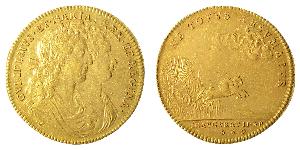John Roettiers
John Roettier;John Roettiers
Place: Antwerp
Born: 1631
Death: 1703
Biography:
John Roettiers was a celebrated English engraver and medallist, born in Belgium in 1631. He was the oldest son of Philip Roettiers, a goldsmith of Antwerp. Roettiers took up the profession of stonecutter and medallist, with his earliest known productions being dated 1658 and 1660.
Early Career
In 1661, Charles II of England invited Roettiers and his brother Joseph (and subsequently a third brother Philip) to join the British Royal Mint. By 1662, Roettiers was one of the mint's chief engravers. He was aided by his two sons, James and Norbert.
Notable Works
Roettiers produced many important coin and medal designs throughout the reign of Charles II, including a new Great Seal in 1666–1667. He also produced the official coronation medals of James II of England (1685) and William III and Mary II (1689). His work can be found in various museums, including the British Museum and the National Gallery.
Awards and Recognition
Roettiers' work was highly regarded by his contemporaries. He was a member of the Royal Society and was elected as a Fellow in 1669. Key Facts about John Roettiers:
- Born: 1631, Belgium
- Died: 1703
- Occupation: Engraver and medallist
- Notable works: Great Seal (1666–1667), coronation medals of James II and William III and Mary II
Legacy
Roettiers' legacy can be seen in the many medal and coin designs he produced during his career. His work continues to be admired and studied by art historians and collectors today. For more information about John Roettiers, visit John Roettiers on Wikioo.org. Some of his notable works can also be found on Wikioo.org, including Medal in Honour of a Child by Jean-Bertrand Andrieu. The Kunsthistorisches Museum in Vienna also has an impressive collection of Roettiers' work, including Portrait of Jan de Leeuw by Jan Van Eyck. For more information about the artists and their works, visit Jan van Eyck on Wikioo.org. You can also learn more about other notable artists such as Hans Reinhart The Elder and their works on Hans Reinhart The Elder.

